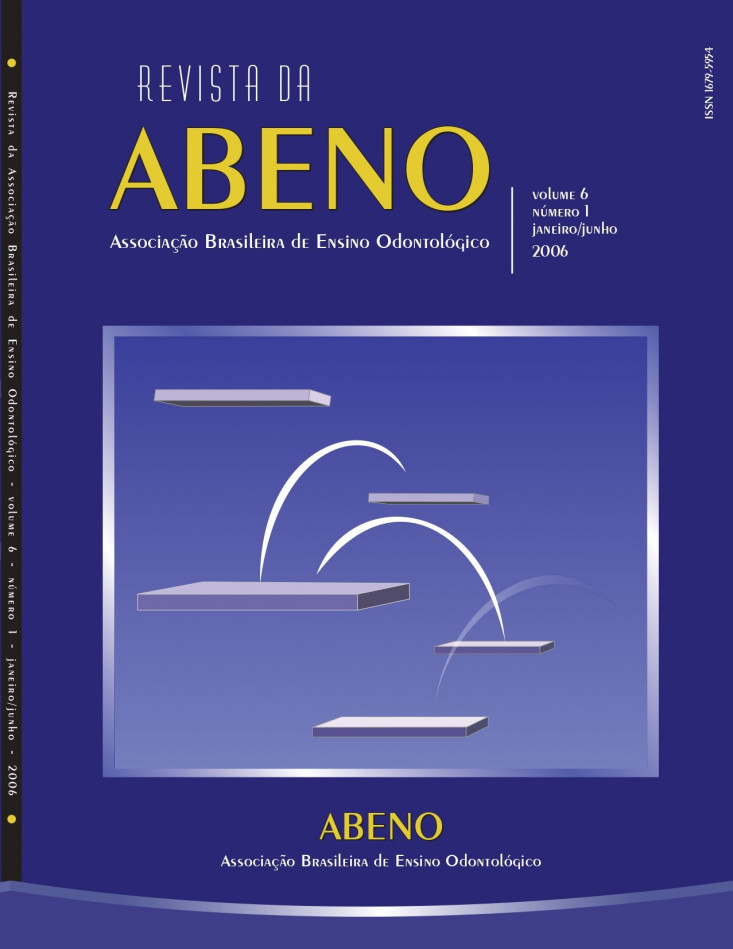Public Health Dentistry in the curricular structure of dental courses in Brazil
DOI:
https://doi.org/10.30979/rev.abeno.v6i1.1453Palabras clave:
Education, dental. Curriculum. Dentistry. Education. Public health dentistryResumen
The area of Public Health Dentistry plays a fundamental role in the formation of the professional as required by the National Curriculum Guidelines for undergraduate courses of Dentistry, implemented in 2002. This study analyzed the characteristics of the disciplines of the area of Public Health Dentistry in the curricula of dental courses in the country, considering the duration of classes, number of terms, name used, course format, teaching methodology, and evaluation. Letters were sent to 123 schools of Dentistry from which at least one class had graduated up to 2003, requesting their curricular structure and syllabus. Fifty colleges sent the material requested back (40.65% of those contacted). The duration of classes apportioned to Public Health Dentistry is heterogeneous, varying from 75 to 699 hours, and 44.18% of the dental schools assigned 200 to 324 hours to this course. In relation to the number of semesters required for Public Health Dentistry, it was found that the participating dental schools apportioned 1 to 8 semesters to this course, and most of them assigned 2 or 3 semesters (20.93% each) or 4 semesters (27.91%) to Public Health Dentistry. The name used by the schools to refer to the area of Public Health Dentistry varied, and Social and Preventive Dentistry was most commonly used (30%). It was observed that all courses had a theoretical-practical character. Teaching methodologies or strategies cited most often by the schools were expositive classes (100%) and seminars (71.88%). The evaluation was usually performed by means of written tests (100%) and practical tests (80%). It can be concluded that, in relation to the characteristics analyzed in the area of Public Health Dentistry, most colleges offer a class duration of 75 to 324 hours, have 2 to 4 semesters for teaching the class contents, the most used name to refer to this area is Social and Preventive Dentistry, all courses have a theoreticalpractical character; the most often cited teaching methodologies are expositive classes and seminars; and written tests and practical tests are the most commonly used methods for evaluation in the syllabi.Descargas
Citas
Álvarez TB. La nueva formación odontológica y el compromiso social con las comunidades. Rev Bras Odontol Saúde Coletiva 2000;(nº esp):83-90.
Ayers CS, Abrams RA, McCunniff MD, Goldstein BR. A comparison of private and public dental students’ perceptions of extramural programming. J Dent Educ 2003;67(4):412-7.
Behrens MA. Projetos de aprendizagem colaborativa num paradigma emergente. In: Moran JM, Masetto MT, Behrens MA. Novas tecnologias e mediação pedagógica. Campinas: Papirus; 2000. p. 67-132.
Brasil. Conselho Federal de Odontologia. Resolução CFO22/2001. Baixa Normas sobre anúncio e exercício das especialidades odontológicas e sobre cursos de especialização revogando as redações do Capítulo VIII, Título I; Capítulo I, II e III, Título III, das Normas aprovadas pela Resolução CFO-185/93, alterada pela Resolução CFO-198/95. [acesso em 2004 mar 20]. Disponível em: URL: http://www.cfo.org.br/default01.cfm.
Brasil. Ministério da Educação e Cultura. Conselho Nacional de Educação. Resolução CNE/CES 3/2002. Diário da União,
mar 2002. [acesso em 2003 jun 08]. Disponível em: URL: http://www.mec.gov.br/sesu/ftp/resolucao/03020odontologia.doc.
Brasil. Ministério da Educação e Cultura. Parecer CNE/CES nº 329/2004. Carga horária mínima dos cursos de graduação, bacharelados, na modalidade presencial. [acesso em 2004 dez 01]. Disponível em: URL: http://www.abeno.org.br.
Brasil. Parecer nº 370, de 9 de julho de 1982. Proposta do novo currículo mínimo para o Curso de Graduação em Odontologia CCC. Documenta 1982;260:46-54.
Chaves MM. A odontologia no componente acadêmico dos projetos UNI. [acesso em 2003 out 12]. Disponível em: URL: http://www.ibiblio.org/taft/cedros/portugues/newsletter/n4/dentacde.html.
Chaves MM. Odontologia social. 3ª ed. São Paulo: Artes Médicas; 1986. 448 p.
Estrela C. Projeto de ensino. In: Estrela C. Metodologia científica: ensino e pesquisa em odontologia. São Paulo: Artes Médicas; 2001. p. 19-34.
Franco A. Metodologia de ensino: didática. Belo Horizonte: Lê; 1997. 88 p.
Gil AC. Métodos e técnicas de pesquisa social. 3ª ed. São Paulo: Atlas; 1991. 207 p.
Medeiros UV. Integração docente-assistencial em odontologia no Brasil. Educ Méd Salud 1991;25(2):126-37.
Moimaz SAS, Saliba NA, Garbin CAS, Zina LG, Furtado JF, Amorim JA. Serviço extramuro odontológico: impacto na formação profissional. Pesq Bras Odontoped Clin Integr 2004;4(1):53-7.
Narvai PC. Odontologia e saúde bucal coletiva. São Paulo: Hucitec; 1994. 113 p.
Paula LM, Bezerra ACB. A estrutura curricular dos cursos de odontologia no Brasil. Revista da ABENO 2003;3(1):7-14.
UNESCO. Declaração mundial sobre educação superior. Piracicaba: UNIMEP; 1998. 51 p.
Werneck MAF, Lucas SD. Estágio supervisionado em odontologia: uma experiência da integração ensino/serviço de saúde bucal. Arq Centro Estud Curso Odontol 1996;32(2):95-108.
Descargas
Publicado
Cómo citar
Número
Sección
Licencia
Autores que publicam nesta revista concordam com os seguintes termos:
a) Autores mantém os direitos autorais e concedem à revista o direito de primeira publicação, com o trabalho simultaneamente licenciado sob a Licença Creative Commons Attribution que permite o compartilhamento do trabalho com reconhecimento da autoria e publicação inicial nesta revista.
b) Autores têm autorização para assumir contratos adicionais separadamente, para distribuição não-exclusiva da versão do trabalho publicada nesta revista (ex.: publicar em repositório institucional ou como capítulo de livro), com reconhecimento de autoria e publicação inicial nesta revista.
c) Autores têm permissão e são estimulados a publicar e distribuir seu trabalho online (ex.: em repositórios institucionais ou na sua página pessoal) a qualquer ponto antes ou durante o processo editorial, já que isso pode gerar alterações produtivas, bem como aumentar o impacto e a citação do trabalho publicado (Veja O Efeito do Acesso Livre).






